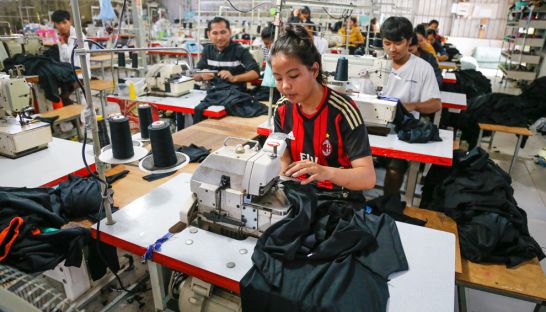Cambodia: Economy to face new challenges
Cambodia’s economic growth remained strong last year though the Kingdom must now address major systemic challenges to build on its ascension into lower-middle income status in order to maintain healthy levels of development, the Asian Development Bank (ADB) said in its annual report yesterday.
The ADB flagship report, titled Asian Development Outlook 2017: Transcending the Middle-Income Challenge, forecasts that Cambodia’s GDP growth rate will remain stable over the next two years at 7.1 percent, up slightly from 7 percent in 2016. Inflation is expected to increase this year to 3.4 percent, up from 3 percent in 2016, and will continue to increase incrementally in 2018 to 3.5 percent.
Samiuela Tukuafu, country director for the ADB, said during the launch of the report that Cambodia’s industrial sector growth, which is the biggest contributor to the country’s GDP, suffered from the recent global economic slowdown, bringing its growth to 10.5 percent in 2016, down from 11.7 percent in 2015. The industrial sector remains mostly focused on garment and footwear production, he added, and it should bounce back as global economic conditions improve.
“This year, GDP is expected to grow slightly higher [than anticipated] supported by higher growth in the major industrial countries,” he said.
“Cambodia could take advantage of the potential relocation of light manufacturing industries out of China by attracting further foreign direct investment into other non-garment and footwear sectors.”
Services, the Kingdom’s second largest economic sector, grew by 6.7 percent, down from 7.1 percent the previous year, while agriculture recovered from flat growth in 2015 to a modest 1.8 percent last year, partly on the back of improved rainfall after a prolonged and devastating drought, Tukuafu explained.
He added that the Kingdom remains exposed to several domestic and external risks that could slow the country’s efforts for development. “Domestic risk would originate from rapid expansion of the financial sector, mainly seen through the proliferation of microfinance institutions,” he said.
“External risk to the outlook includes firstly, disappointing growth in the Euro area, secondly, a tightening of credit globally, and thirdly dollar surges due to higher interest rates, which could affect the country’s export competitiveness.”
Jan Hansen, senior country economist for the ADB in Cambodia, said the Kingdom needs to build on its ascension to a lower-middle income status by implementing measures that would add value to exports and support local industries.
“In the longer perspective, Cambodia’s successful growth model of attracting foreign direct investment through inexpensive low-skilled and abundant labour, which has delivered the impressive economic expansion over the recent past, may not be viable much longer,” he said. “Productivity growth has been slow, while labour costs and skill shortages are increasing.”
A key area to ensure continued growth for Cambodia is improving education, Hansen said. He added that facilitating entrepreneurship and innovation were also key pillars for the Kingdom’s economic success.
“The government must shape an environment conducive to innovative entrepreneurship by promoting investments in education and in infrastructure,” Hansen said.
“This analysis is very timely for Cambodia after its graduation to a lower-middle income country, and the measures that are important to keep high growth sustained over the medium term is the nexus of advanced infrastructure, highly developed skills and innovation.”
He said investments into these categories could help sustain growth and ensure a successful transition into a middle-income to higher-income country without getting stuck in the middle-income trap.
Mey Kalyan, senior adviser to the Supreme National Economic Council, said the government was actively working to improve key sectors of the economy and expand its business environment. However, he admitted that it was not happening fast enough.
“I think looking at the past, we have been growing as much as we can, but it is not enough,” he said. “If Cambodia wants to move forward, it has to do better in terms of infrastructure, and also deal with its problem of energy and electricity.”
Kalyan explained that current energy production hindered industrial development and prevented the country from adopting more advanced forms of manufacturing. He added that the government needs to remain wary of potential risks to its exports, particularly for garments, that could be affected by the growth of rival garment exporters such as Vietnam.
“Today [development measures] could be done better, but we are improving according the demands of the market,” he said.
Source: http://www.phnompenhpost.com/business/economy-face-new-challenges


 Thailand
Thailand




